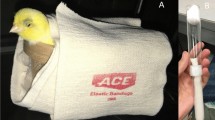Abstract
Serial sections of females of two highly filariasusceptible mosquitoes,Aedes togoi andAe. aegypti, were examined by light microscopy. Following a singleBrugia pahangi infection, the predominant reaction of flight muscles ofAe. aegypti was degeneration, whereas that inAe. togoi was nuclear enlargement, a putative repair response. This also holds true following mechanical injury (Beckett 1990), suggesting an inherent species difference in flight-muscle response to injury. The filariae of a secondB. pahangi infection, initiated after muscle damage had been established, usually avoid degenerate muscle fibres (which cannot support larval development) but entered similar proportions of normal fibres and those with enlarged nuclei. Filariae of a second infection, initiated whilst first-infection larvae were still within the muscle fibres, entered similar proportions of already-parasitized and non-parasitized fibres. The sole change in muscle fibres detectable by filarial larvae is therefore degeneration.
Similar content being viewed by others
References
Beckett EB (1971) Histological changes in mosquito flight muscle fibres associated with parasitization by filarial larvae. Parasitology 63:365–372
Beckett EB (1973) Some quantitative aspects of flight muscle damage in mosquitoes infected with filarial larvae. Ann Trop Med Parasitol 67:455–466
Beckett EB (1990) The non-specific nature of the response of mosquito flight muscle to filarial parasitization. Parasitol Res 76:360–366
Hockmeyer WT, Schiefer BA, Redington BC, Eldridge BF (1975)Brugia pahangi: effects upon flight capability ofAedes aegypti. Exp Parasitol 38:1–5
Lok JB, Cupp EW, Braide EI, Bernardo MJ (1980)Aedes aegypti as a surrogate host forOnchocerca species. Am J Trop Med Hyg 29:382–388
Macdonald WW (1962) The selection of a strain ofAedes aegypti susceptible to infection with semiperiodicBrugia malayi. Ann Trop Med Parasitol 56:368–372
Newcomer EM (1953) A new cytological and histological fixing fluid. Science 118:161
Townson H (1970) The effect of infection withBrugia pahangi on the flight ofAedes aegypti. Ann Trop Med Parasitol 64:411–420
Wade JO (1976) A new design of membrane feeder incorporating an electrical blood stirring device. Ann Trop Med Parasitol 70:113–120
Wharton RH (1962) The biology ofMansonia mosquitoes in relation to transmission of filariasis in Malaya. Bulletin 11 (new series), Institute for Medical Research. Federation of Malaya
Author information
Authors and Affiliations
Rights and permissions
About this article
Cite this article
Beckett, E.B. Species variation in mosquito flight-muscle damage resulting from a single filarial infection and its repercussions on a second infection. Parasitol Res 76, 606–609 (1990). https://doi.org/10.1007/BF00932571
Accepted:
Issue Date:
DOI: https://doi.org/10.1007/BF00932571




